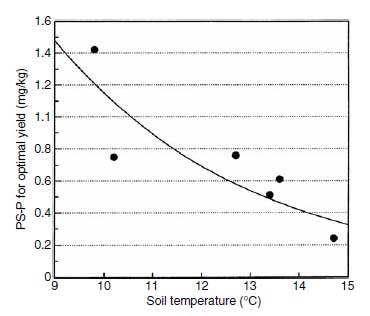Soil Temperature
Soil temperature affects reactions that govern the dissolution, adsorption and diffusion of phosphorus. Although sorption and desorption generally occur concurrently, an increase in soil temperature increases kinetics of reactions (82) and enables more rapid equilibration among nonlabile, labile, and solution phosphorus pools, resulting in more rapid replenishment of solution phosphorus as phosphorus is taken up by crops. Sutton (83) concluded that most of the effect of temperature on available phosphorus was due to inorganic reactions, since the effect occurred too rapidly to be explained by microbial mineralization.Soil temperature also has the potential to affect root uptake of phosphorus. With excised corn roots in solution culture experiments, Carter and Lathwell (84) reported that absorption increased as temperature was increased from 20 to 40°C. The effects of temperature on soil reactions may be more important than effects on plant physiology. Singh and Jones (85) noted that changes in temperature had a more pronounced effect on the phosphorus nutrition of Boston lettuce in soil culture than in solution culture.
 |
| FIGURE 3.8 Soil test phosphorus level using phosphorus sorption (PS-P) required for maximum yield of lettuce as affected by soil temperature. (Adapted from Gardner and Sanchez, unpublished data.) |
In production systems where crops are seeded and harvested over the same time interval each year, soil temperature is unlikely to substantially confound soil-test-based fertilizer recommendations for phosphorus. However, in crop production situations where planting and harvesting are extended over seasonal changes, such as many vegetable production systems, temperature changes can affect the amount of fertilizer required for maximum production. Lingle and Davis (86) reported that tomatoes seeded in cool soils showed a larger growth (dry mass) response to phosphorus than those seeded in warm soils. Locascio and Warren (87) noted that tomato (Lycopersicon esculentum Mill.) growth increased with applications up to 550 kg P/ha at 13°C but only to 140 kg P/ha at 21 or 30°C. Research has shown that the phosphorus rate required for maximum production of lettuce in deserts increased as temperatures during the growing season decreased (88,89). Lettuce produced in the desert of southwestern United States is planted every day from September through January and is harvested daily from November through April with mean soil temperatures ranging from 4 to 18°C. As illustrated in Figure 3.8, soil-test levels for phosphorus requirement for maximum lettuce yield decreased as mean soil temperature during the growing season increased.




